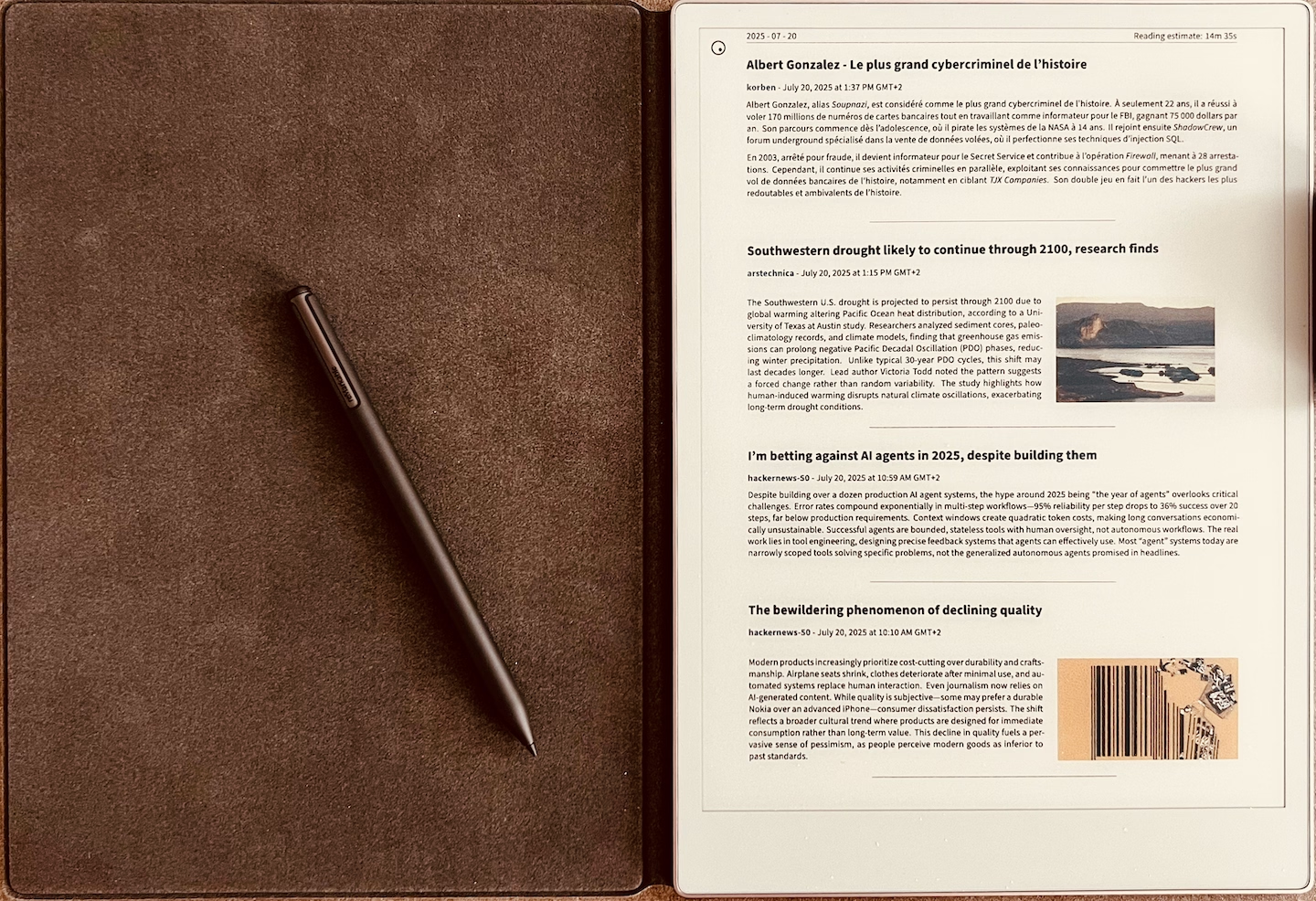2025 - Reading the News Grandpa-Style in 2025
I recently started experimenting with a small project called "Morning Nerds" using a ReMarkable device for reading news. But why take this approach?

The Problem with Social Media Noise
I used to check news (tech, world, and local) on Mastodon and Bluesky. While I primarily use Mastodon, I follow some users on Bluesky as well. Although it's convenient to have everything centralized in Mastodon, there's simply too much mixed content and noise to efficiently get the information I actually want and let's not talk about ads pollution 😊.
This led me to experiment with an old but reliable technology: RSS. Yes, RSS is quite dated, but it still does the job effectively and arguably better than social media for news consumption. I migrated all the news sources I could access via RSS feeds and kept only the people I'm genuinely interested in following on social platforms.
The result is a daily PDF that I generate from RSS feeds, complete with summaries. It's incredibly peaceful to read, especially when I'm outside in a park or at a coffee shop. This approach has also changed how I interact with social media meaning I visit these platforms much less frequently than before.
I experimented with converting the newsfeed into a podcast format for listening during walks, but it quickly became clear this approach doesn't work for curated news consumption or at least for me. The fundamental issue is selectivity. When reading, I can easily scan headlines and skip entire sections that don't interest me, moving effortlessly from a graphics programming update to a climate tech story while completely bypassing cryptocurrency news. But with audio, you're locked into a linear experience. Skipping content while walking means fumbling with playback controls, breaking your stride, and often missing the transition to something actually relevant. This reinforced why the visual, text-based format works so well for this type of content consumption. Reading allows for the kind of selective attention that makes curated news feeds truly valuable.
How It Works
The setup is straightforward. I maintain a configuration file containing RSS feeds, and each day I generate a PDF through these steps:
- Fetch new articles from RSS feeds
- Create summaries using an LLM (Large Language Model) to create a summary of the article
- Add illustrative images when I find relevant images in the article
- Build the PDF using all articles summarized
What's the current tech stack ?
The tech stack is mixed of nodejs/typescript and installed tools:
- nodejs / typescript
- pandoc to convert markdown to PDF
- template from Wandmalfarbe
Why PDF format?
While EPUB format works on reader devices, the subset of HTML/CSS support varies significantly across devices, and some clearly limit certain features. To generate a nice layout with features like two-column formatting, PDF is the most reliable option.
What's Next
I'd like to add filtered content from social media for the people I follow. Currently, I mainly follow graphics programming developers, and while I appreciate that this community expresses themselves as humans (please don't stop!), when I'm looking for technical news, I want to extract only the technical information, filtering out cats, politics, boats, and other personal content (though boats and cats pictures are great, by the way! 😊).
My current system works well for getting an overview of what's happening, but it doesn't provide full details. For complete information, I still need to use my computer and click on links in the PDF. But it's a huge win to get a full overview before clicking on everything to read the content. Ideally, I'd like to mark items on the ReMarkable so I could have a reading list on my computer. However, the ReMarkable API is currently too limited for this functionality. I'd love to automate this process, but I'll probably have to wait for a richer API.
The overall experience is good, but the code is still in a messy state and I will need to clean it up before publishing or opening the service to others.
Conclusion
I'm not sure if I'm the only one frustrated by the growing amount of time wasted trying to find valuable content on the web. While prototyping this tool, I was struck by the incredible amount of noise we have to filter through to get to the actual content we want.
If you have recommendations for existing tools or ideas that might be interesting for this project, please don't hesitate to reach out. I'm far from being an expert in this area, I simply trying to avoid wasting time while getting the information I want.
I am not sponsored by ReMarkable but the device is great, I would like better API to access device with REST api to implement better workflow with web tech.
I now understand why my grandfather enjoyed reading the newspaper outside with his coffee. It's a truly peaceful routine.